View count:
9427
International Research Network
Smart drones (or aerial robotics) can effectively serve many of the sustainable development goals (SDG), which encompass quality education, clean water, industry, innovation, and infrastructure. To host an international research network for SDG drone, a cross-disciplinary engineering team is formed at National Yang Chiao Tung University (NYCU), Hsinchu, Taiwan since 2020s. Hereby, we host series of seminars, short courses to promote exchanges of ideas and research collaboration.
| Date | Speaker | Title | Time | Location@NYCU | Host | Record Video |
| 2023/ 11/3 |
Professor Yue Zhongqi, Department of Civil Engineering, University of Hong Kong |
Analytical solutions and applied research on elastic mechanics of multilayered or functionally graded material | 15:30-17:20 | Engineering Bldg 2 EB227 |
Ernian Pan, Department of Civil Engineering, NYCU |
|
| 2023/ 11/16 |
Associate Professor Jong Kwon Choe, Department of Civil and Environmental Engineering of Seoul National University |
Development of “selective” monitoring and treatment technologies for emerging contaminants in water | 14:45-16:45 | Insitute of Environmental Engineering Bldg Level 1 room 102 |
Yi-Hsueh Chuang, Department of Environmental Engineering, NYCU | |
| 2023/ 12/9,10 |
Dr Jonathan Tay Chien Ming Department of Mechanical Engineering, National University of Dingapore Lua Kim Boon Department of Mechanical Engineering, NYCU |
Short Course: Sustainable UAV Technologies |
12/09 (Sat.) 08:00-20:20 12/10 (Sun.) 08:00-18:20 |
Engineering Bldg1 EA101 |
Lua Kim Boon Department of Mechanical Engineering, NYCU |
|
| 2023/ 11/26 2023/ 12/3 |
LAU, Gih Keong Department of Mechanical Engineering, NYCU Yi-Hsueh Chuang Department of Environmental Engineering, NYCU |
Short Course:
|
11/26 (Sun.) 09:00-18:20 12/03 (Sun.)09:00-18:20 |
11/26 Engineering Bldg5 EE106 [GF] 12/03 Engineering Bldg1 EAB06 [GF] |
||
| 2023/ 11/28 |
Prof. Marco Fontana, Scuola Superiore Sant’Anna,Pisa, Italy Prof. Jun Shintake, University of Electro-Communications (UEC), Tokyo, Japan |
Title1: Fluid-gap zipping electrostatic actuators Title2: Soft actuators, sensors, and robots |
14:00-17:00 | Engineering Bldg5 EE324 [GF] |
LAU, Gih Keong Department of Mechanical Engineering, NYCU |
|
| 2023/ 12/04 |
Speaker 1. Prof. Takeshi Hayakawa, Faculty of Science and Engineering, Chuo University Speaker 2. Prof. Niko Kimura, Division of Advanced Mechanical Systems Engineering, Institute of Engineering, Tokyo University Speaker 3. Prof. Yoshitaka Shirasaki, Research Center for Advanced Science and Technology, The University of Tokyo Speaker 4. Prof. Naotomo Tottori, Department of Mechanical Engineering, Kyushu University Speaker 5. Prof. Maasa Yokomori, Department of Mechanical Engineering, Kyushu University Speaker 6. Prof. Shinya Sakuma, Department of Mechanical Engineering, Kyushu University |
Title1. Massive integrated on-chip gel actuator for single cell manipulations Title2. Nanoscopic design of molecular delivery using “nanoparticles based on lipids” Title3. LCI-S and TDCSS, the pioneering tools to reveal cellular secretory responses Title4. On-chip continuous particle/cell separation through micropillar arrays Title5. Programmable DNA–metal hybrid structures with the ability of interacting with biomolecules Title6. Cell manipulation with high-speed & high-resolution based on "flow reduction mechanisms" |
9:00-12:00 | Engineering Bldg5 EE436 [GF] |
Chia-Hung Dylan Tsai Department of Mechanical Engineering, NYCU |
|
| 2023/ 12/11 |
Speaker1: Dr Jonathan Tay Chien Ming Speaker2: Dr Sunil Manohar Dash Speaker3: Dr. Sunita Mishra |
Title1: Heat transfer with shallow dimples of different geometries in a turbulent channel flow Title2: High-Frequency Flapping Aerodynamics of airfoils with and without leading-edge tubercles Title3: High Strain Rate Characterization of Rocks and its Application in Blast Analysis of Tunnels |
13:00-16:00 | change to Engineering Bldg5 EE324 [GF] |
Lua Kim Boon Department of Mechanical Engineering, NYCU |
|
| 2023/ 12/12 |
Speaker 1. Prof.Pakpong Chirarattananon, Departments of Biomedical Engineering and Mechanical Engineering at City University of Hong Kong Speaker 2. Prof.Teng-Hu Cheng, Department of Mechanical Engineering, NYCU Speaker 3. Dr. Wee-Beng TAY, Department of Mechanical Engineering, National University of Singapore |
Title1: Nature's Flying Machines: Lessons for Small Aerial Robots Title2: Control and Applications of Networked UAV systems Title3: Numerical investigation of flapping wing and morphing unsteady flight |
14:00-17:00 | Engineering Bldg5 EE324 [GF] |
LAU, Gih Keong Department of Mechanical Engineering, NYCU Teng-Hu Cheng, Department of Mechanical Engineering, NYCU |
|
| change to 2023/ 12/28 |
Prof. C W LIM (林志華), Department of Architecture and Civil Engineering, City University of Hong Kong | Theory, Numerical Analysis and Experiments of Acoustic and Seismic Metamaterials and Metastructures | change to 10:30-12:00 |
Engineering Bldg2 EB117 |
Ernian Pan, Department of Civil Engineering, NYCU |
|
| 2023/ 12/14 |
Prof. Wei-Hsin Liao, Chairman and Choh-Ming Li Professor of Mechanical and Automation Engineering The Chinese University of Hong Kong Shatin, N.T., Hong Kong, China |
Smart Materials, Adaptive Structures and Intelligent Systems | 14:00-15:20 | Engineering Bldg5 EE324 [GF] |
LAU, Gih Keong Department of Mechanical Engineering, NYCU |
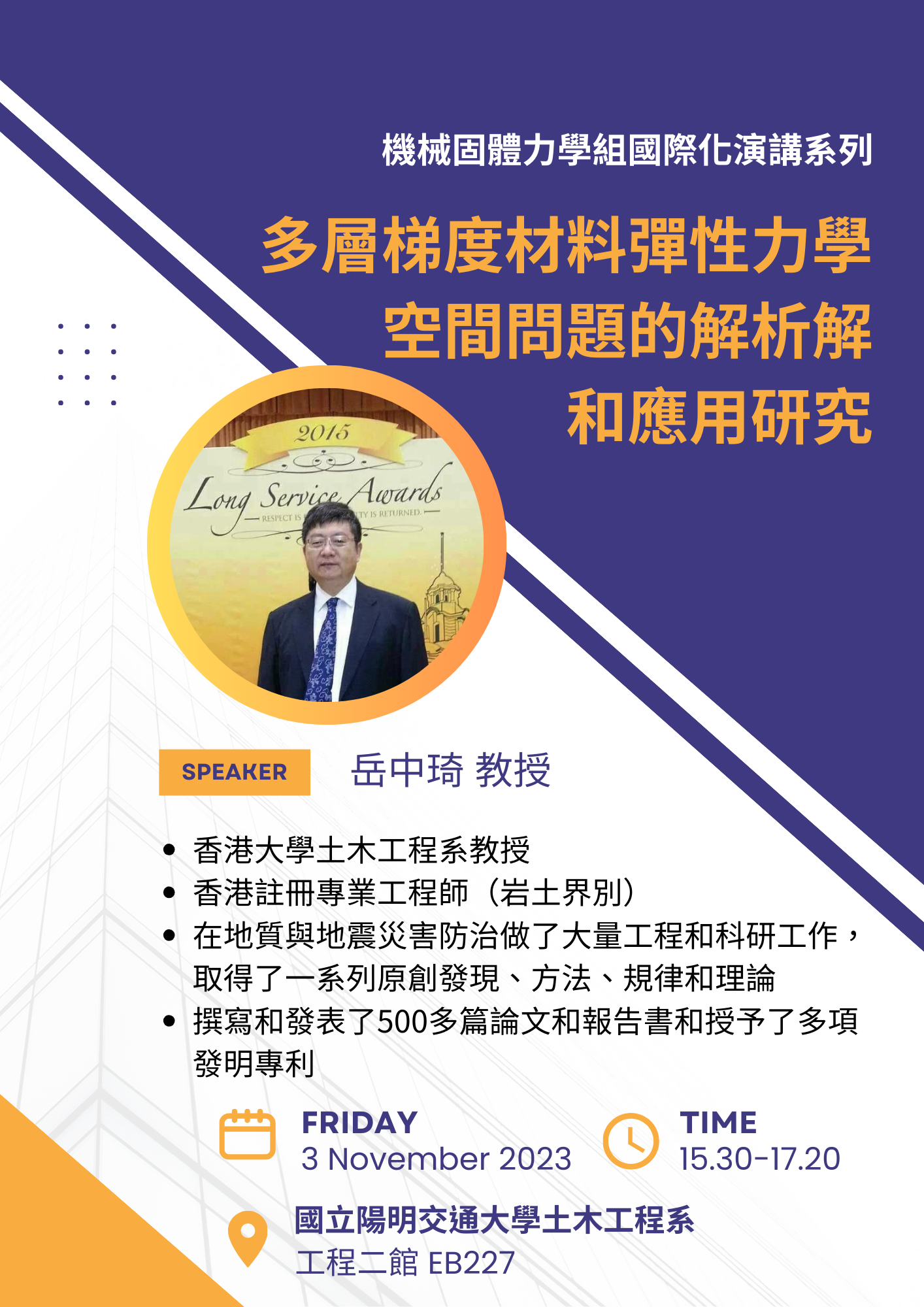 Analytical solutions and applied research on elastic mechanics of multilayered or functionally graded material
Analytical solutions and applied research on elastic mechanics of multilayered or functionally graded materialSpeaker:Yue Zhongqi(Professor, Department of Civil Engineering, University of Hong Kong)
Date:2023/11/3
Abstract
彈性力學理論起源於 300 年前伽利略、胡克和牛頓時代。隨著經典微積分和勢場理論的發展,這套理論被包括楊氏、泊松、納維、柯西和格林在內的數學、物理和力學家們在1830-1840年建立。之後,眾多科技人員做了大量科學與工程問題的解析解研究,以精準分析、預測和設計材料彈性和斷裂力學回應。重要的閉合基本解包括在均質彈性材料的1848年Kelvin全空間解,1885年Boussinesq半空間解和1936年Mindlin半空間解。百多年來,雖然科研人員對非均質彈性材料的相關問題做了大量研究,但是,他們給出的非均質材料彈性力學邊值(含混合邊值)問題的以簡單或特殊和諧函數表示的閉合基本解極少。這一直是個難以解決的國際性數學力學難題。在本報告中,岳中琦教授將介紹,自1983年在北京大學攻讀碩士學位以來,他是如何有條件地攻克了上述國際力學難題,將已知的大量在均質彈性材料空間邊值或混合邊值問題的閉合基本解或解析解,完全解析地拓展到多層梯度非均質材料空間邊值或混合邊值問題的閉合基本解或解析解。
Biography Yue Zhongqi
岳中琦現任香港大學工程學院岩土工程教授,香港註冊專業工程師(岩土界別)。1979-1983年獲北京大學地震地質專業理學學士。1983-1986年獲北京大學地球動力學方向碩士學位。1988-1992年獲加拿大Carleton大學岩土工程博士學位。他曾在北京、渥太華和香港多年從事近十年科技實踐。40年來,他在地質與地震災害防治做了大量工程和科研工作,取得了一系列原創發現、方法、規律和理論。他用撰寫和發表了500多篇論文和報告書和授予了多項發明專利。獲得的獎勵包括:1983年北京大學優秀畢業生稱號;1992年加拿大聯邦政府自然科學和工程基金博士後獎;2006年茅以升土力學及岩土工程青年獎;2007年國家(香港)傑出青年科學基金獎;2008年國際岩土力學計算方法與進展學會優秀貢獻獎;中國地質學會2011年學術年會優秀論文獎;中國岩石力學與工程學會科學技術獎的2018年第九屆自然科學二等獎、2019年第十屆自然科學一等獎和2020年第十一屆自然科學一等獎;2020年度中國數字模擬科技獎(傑出貢獻奖);2020年香港大學工程學院團隊傑出教學獎。
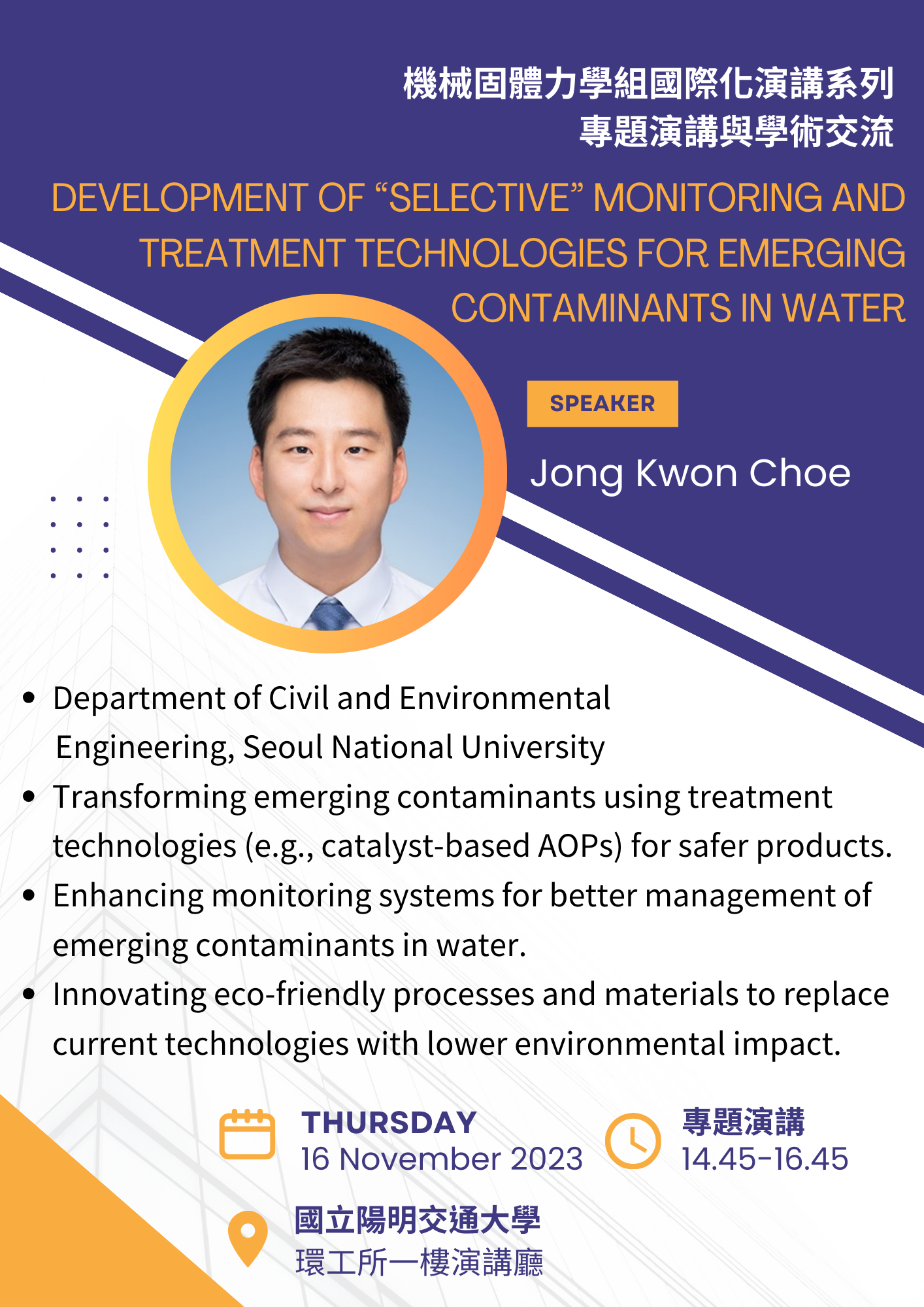 Development of “selective” monitoring and treatment technologies for emerging contaminants in water
Development of “selective” monitoring and treatment technologies for emerging contaminants in waterSpeaker:Jong Kwon Choe (Associate Professor, Department of Civil and Environmental Engineering of Seoul National University)
Date:2023/11/16
Abstract
Increased production and use of anthropogenic chemicals led to continuous occurrence of emerging contaminants in water that pose a significant concern to aquatic organisms and human health at concentrations of nanograms to microograms per liter (ng/L to ug/L), which are several orders of magnitude lower than concentrations of more conventionally recognized inorganic and organic constituents in water. To safely manage water containing these emerging contaminants, there is a need for exploring materials and technologies for monitoring and treatment that selectively interact with these emerging contaminants over other constituents. This presentation will cover our recent and ongoing efforts to develop 1) selective monitoring technologies for per- and polyfluorinated alkyl substances (PFASs) based on aptasensors and 2) selective treatment technologies for pharmaceutical compounds based on metal catalysts with their surfaced coated with molecularly imprinted polymers (MIPs).
Biography Jong Kwon Choe
Dr. Choe is currently an Associate Professor in Department of Civil and Environmental Engineering, Seoul National University in South Korea. He has published more than 30 works in well-known journals. His current research interest lies in 1) application of advanced metal-based catalysis to transform contaminants of emerging concern to environmental benign products and 2) development of novel processes and materials that can supplant current ones with alternatives that have a lower environmental footprint (i.e.,minimal impacts on human health, environmental damages, and resource depletion) and potentially recover embedded resources (i.e., water, energy, nutrition) during the processes.
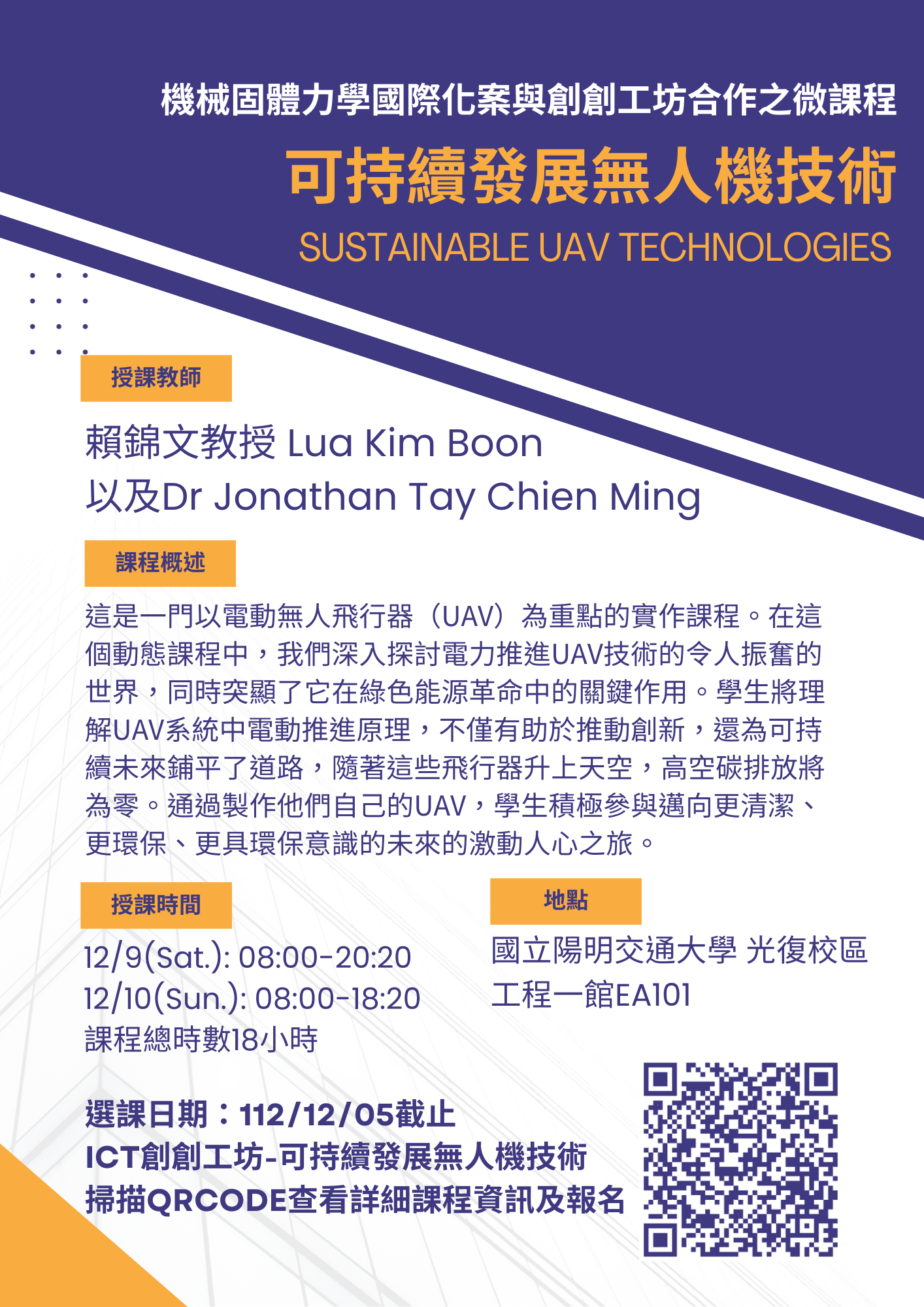 Sustainable UAV Technologies
Sustainable UAV TechnologiesSpeaker:Dr Jonathan Tay Chien Ming and Lua Kim Boon
Date:2023/12/9,10
Registration information: ICT創創工坊 [112-1微學分課程] 可持續發展無人機技術Sustainable UVA Technologies
Abstract
This is a hands-on course focused on electric Unmanned Aerial Vehicles (UAVs). In this dynamic program, we delve into the electrifying world of electric propulsion UAV technology while highlighting its pivotal role in the green energy revolution. Students will uncover the principles of electric propulsion in UAV systems, not only empowering innovation but also paving the way for a sustainable future with the promise of zero CO2 emissions as these aircraft take to the skies. Through building their own UAVs, students actively participate in the exciting journey toward a cleaner, greener, and more environmentally conscious tomorrow.
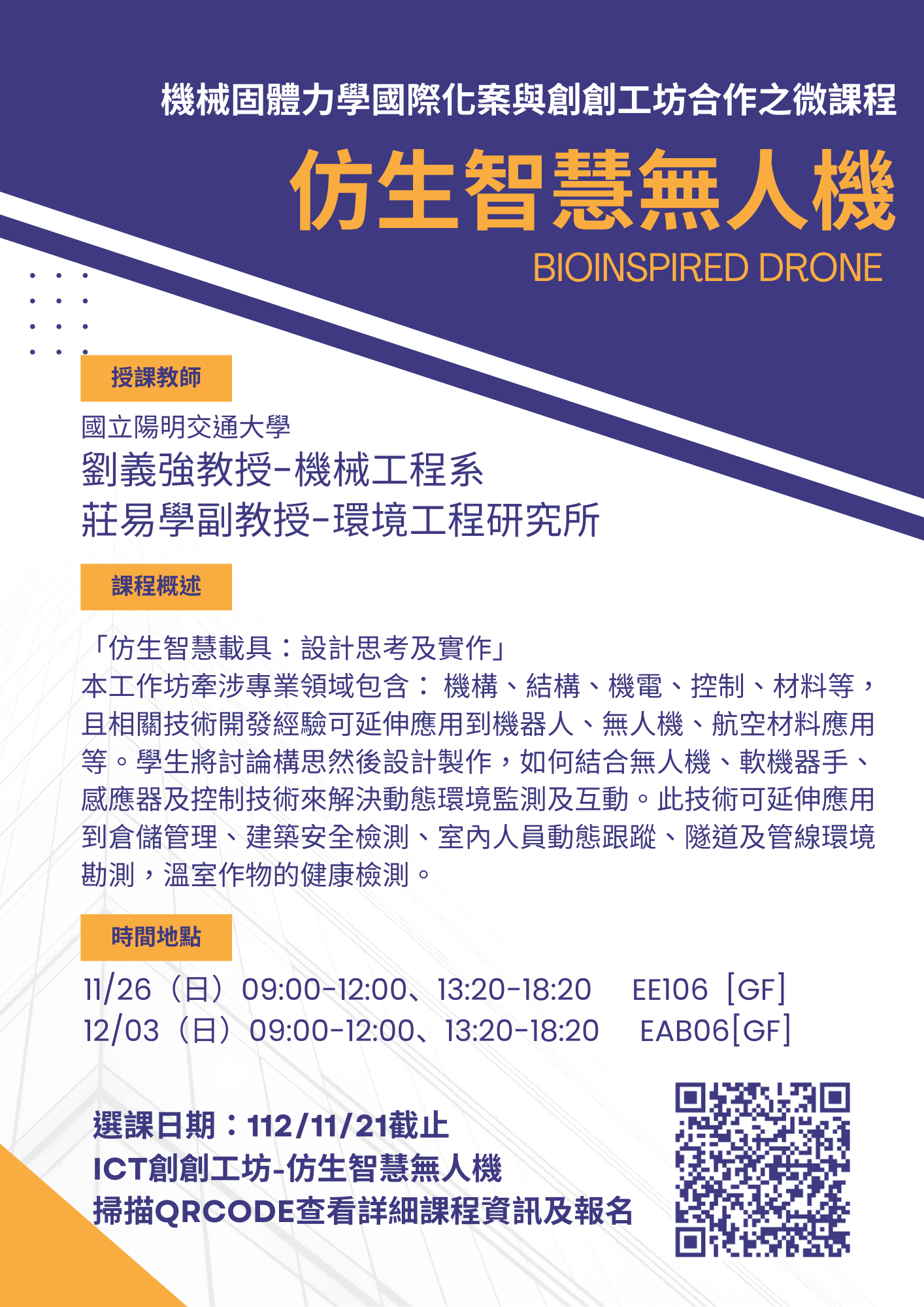 Bioinspired Drone 仿生智慧無人機
Bioinspired Drone 仿生智慧無人機Speaker:LAU, Gih Keong (Department of Mechanical Engineering, NYCU)
and Yi-Hsueh Chuang (Department of Environmental Engineering, NYCU)
Date:2023/11/26 , 2023/12/03
Registration information: ICT創創工坊 [112-1微學分課程] 仿生智慧無人機 Bioinspired Drone
Course selection deadline:112/11/21
Abstract
「仿生智慧載具:設計思考及實作」
本工作坊牽涉專業領域包含: 機構、結構、機電、控制、材料等,且相關技術開發經驗可延伸應用到機器人、無人機、航空材料應用等。學生將討論構思然後設計製作,如何結合無人機、軟機器手、感應器及控制技術來解決動態環境監測及互動。此技術可延伸應用到倉儲管理、建築安全檢測、室內人員動態跟蹤、隧道及管線環境勘測,溫室作物的健康檢測。
 Registration form for online
Registration form for online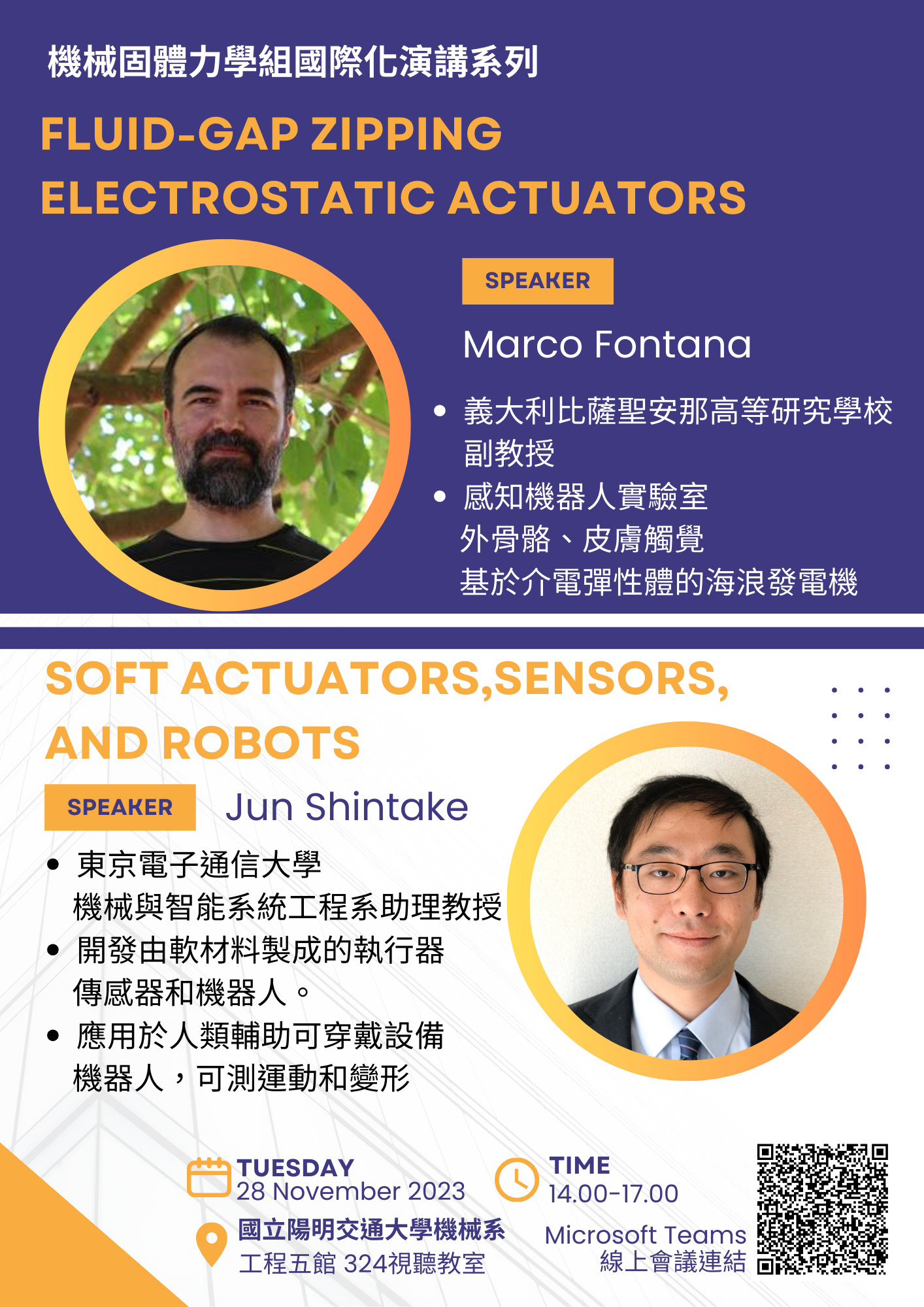 conference
conferenceOnline participation meeting link or scan the QR code on the right.
Fluid-gap zipping electrostatic actuatorsaaa
Speaker:Prof. Marco Fontana, Scuola Superiore Sant’Anna,Pisa, Italy
Date:2023/11/28(Tue.)14:00-17:00
Abstract
In the field of soft robotics, there is a growing interest in innovative electrostatic actuators that utilize fluidic gaps. These actuators offer advantages such as high power density, rapid response, and cost-effectiveness. The actuation method involves the use of dielectric fluids alongside flexible, insulating polymer-based thin-films. These thin-films deform under the effect of high electric fields. Notable examples of these actuators include HASELs, Electro Ribbon Actuators, Electrostatic Bellow Muscles, and other similar architectures.
The primary objective of this presentation is to provide an overview of the current state of this technology. This will be achieved through an examination of the proposed concepts and architectures, shedding light on the most effective architectural and material choices for enhancing performance. Furthermore, the presentation will provide an overview of the existing challenges and ongoing research trends in this field. It will also touch upon the latest developments in the fundamental investigation of interfacial charging phenomena, along with offering insights into potential applications in new fields.
Biography Prof. Marco Fontana
Marco Fontana received the M.S. in mechanical engineering from the University of Pisa in 2003 and Ph.D. in robotics from Scuola Superiore Sant’Anna in 2008. He is currently an associate professor of mechanical engineering at the Institute of Mechanical Intelligence of Scuola Superiore Sant’Anna, where he heads the Robotic Mechanisms and Materials group. His research focuses on novel electromechanical hardware solutions for advanced robotics, including actuators based on smart materials, novel mechanisms and mechatronic systems, and energy harvesting solutions. Before joining the Scuola Superiore Sant’Anna in 2020, he was an Assistant Professor of mechanical engineering at the Department of Industrial Engineering at the University of Trento.
Soft actuators, sensors, and robots
Speaker:Prof. Jun Shintake, University of Electro-Communications (UEC), Tokyo, Japan
Date:2023/11/28(Tue.)14:00-17:00
Abstract
Soft robotics is an emerging field in which robotic systems are created using compliant materials. The inherent compliance makes soft robots being simple, safe, and adaptable to the external environment. Thanks to these features, soft robots have potential multiple applications in manufacturing and food industries, healthcare, teleoperation, observation, and rescue work to name a few. In this talk, I will introduce our work on soft actuators, sensors, and robots based on various principles and materials.
Biography Jun Shintake
Jun Shintake is an associate professor at the University of Electro-Communications (UEC), Tokyo, Japan. He received his B.Eng. and M.Eng. in mechanical engineering from UEC, in 2009 and 2011, respectively. He received his Ph.D. in microengineering from Swiss Federal Institute of Technology in Lausanne (EPFL), Lausanne, Switzerland, in 2016. After that, he worked as a postdoctoral researcher at EPFL. Since 2018 he was working as an assistant professor until 2023 at UEC. His research interests include soft robotics, actuators, and sensors.
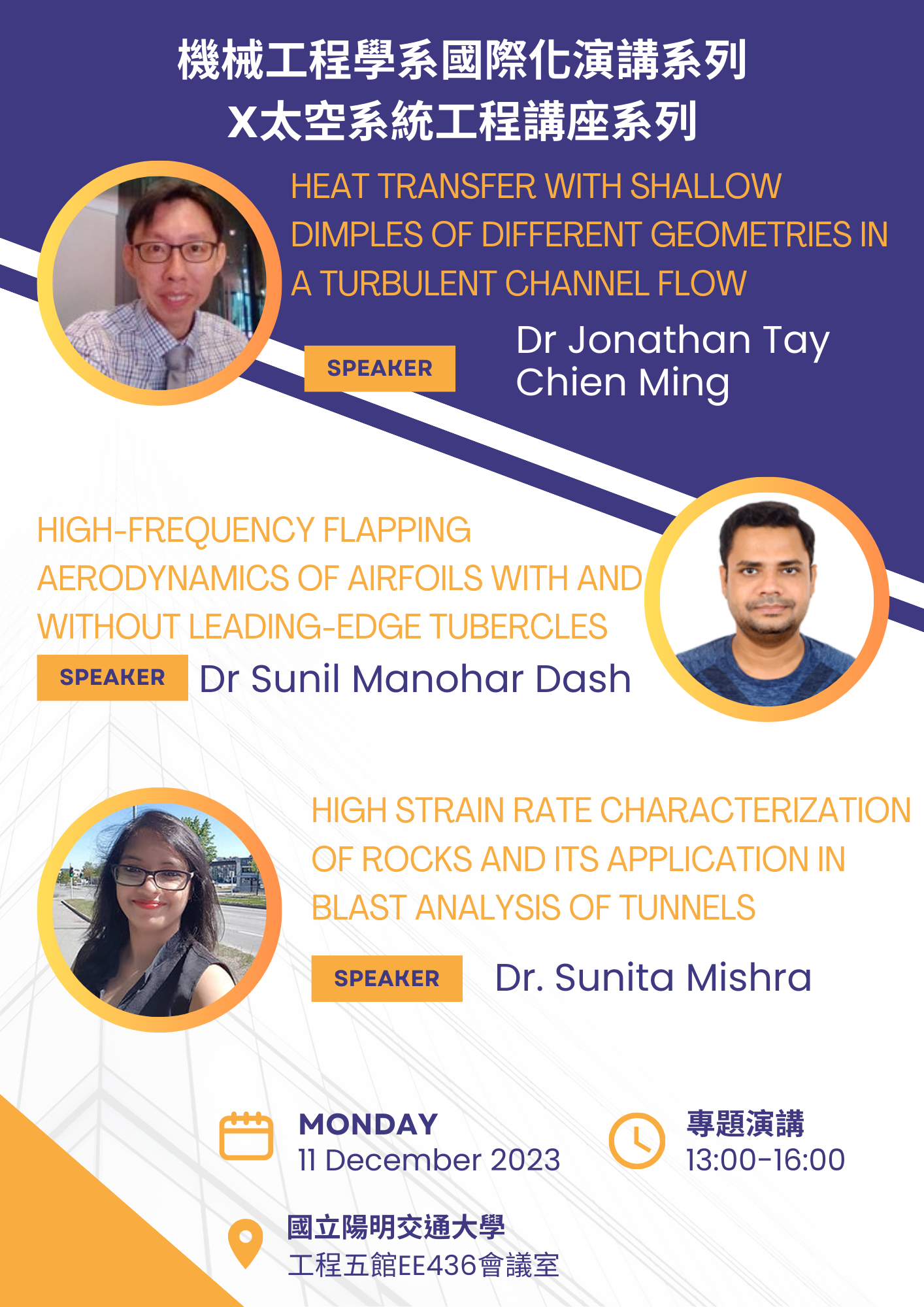 Title1: Heat transfer with shallow dimples of different geometries in a turbulent channel flow
Title1: Heat transfer with shallow dimples of different geometries in a turbulent channel flowSpeaker :Dr Jonathan Tay Chien Ming
Abstract
Dimple arrays offer a passive means to enhance heat transfer with minimal pressure loss. Circular axisymmetric dimples that are most commonly studied often induce a region of separated flow at the upstream portion of the dimple depression, resulting in reduced heat transfer due to the trapping of warm fluid within this recirculating region, as well as increased pressure drag due to the flow separation. Both of these effects naturally lead to reduced heat transfer efficiency of such axisymmetric dimples. To mitigate this, the dimple geometry is manipulated with the aim of reducing the flow recirculation region to enhance the heat transfer and reduce the pressure drop and in so doing, increase the heat transfer efficiency of the dimple surface. The different dimple shapes considered in the current study include the common circular axisymmetric dimples, circular dimples with their deepest point within the dimple depression moved along the streamwise direction, elliptical dimples, teardrop shaped dimples and diamond shaped dimples at constant dimple depth and with smooth rounded dimple edges. Both Direct Numerical Simulation (DNS) and Large Eddy Simulation (LES) were employed to simulate the flow over these dimples at a Reynolds number based on the friction velocity Reτ ∼ 180. The results show the reduction in the flow separation region when the local wall slope at the upstream portion of the dimple is reduced and an increase in the heat transfer efficiency when evaluated in terms of the Area Goodness and Volume Goodness ratios.
BiographyDr Jonathan Tay Chien Ming
Dr. Tay is a distinguished scholar and seasoned professional in the field of Mechanical Engineering, with an expertise that spans cutting-edge research, innovative design, and project management. With a PhD in Mechanical Engineering from NUS, Dr. Tay's research on "Flow past dimpled surfaces" has revolutionized the understanding of drag reduction mechanisms, earning recognition from esteemed research institutions globally. During his tenure as a Senior Research Scientist at Temasek Laboratories, he played a pivotal role in spearheading breakthrough projects in the realm of Aerodynamics, including pioneering work on HALE UAV technologies and bio-inspired research.
Title2: High-Frequency Flapping Aerodynamics of airfoils with and without leading-edge tubercles
Speaker:Dr Sunil Manohar Dash
Abstract
A correctly configured kinematics of a flapping foil generates propulsive force. The efficiency and effectiveness of this flapping foil are crucial considerations in designing unconventional and highly efficient Micro Air Vehicles (MAV) and Autonomous Underwater Vehicles (AUV). A dimensionless parameter that describes the tail or wing kinematics of swimming and flying animals is the Strouhal number (St = fA/U), which divides stroke frequency (f) and amplitude (A) by forward speed (U). St is known to govern a well-defined series of vortex growth and shedding regimes for airfoils undergoing pitching and heaving motions. In this current investigation, we examined the impact of a high flapping frequency of the airfoil on the aerodynamics of forward flight. Additionally, we made an effort to comprehend the influence of the leading-edge profile on flapping aerodynamics by observing airfoils with both smooth and tubercle leading edges.
BiographyDr Sunil Manohar Dash
Dr. Sunil Manohar Dash is an Assistant Professor in the Department of Aerospace Engineering at the Indian Institute of Technology (IIT) Kharagpur, India. Before this position, he worked as a Research Fellow in the International Design Center at the Singapore University of Technology and Design and Massachusetts Institute of Technology Alliance (SUTD-MIT), Singapore, and in the Mechanical Engineering Department at the National University of Singapore (NUS), Singapore. He earned his Ph.D. Degree from the National University of Singapore (NUS), Singapore, in 2014, and a B.Tech degree in Mechanical Engineering from the National Institute of Technology (NIT), Rourkela, India, in 2009. He has been honoured with the Young Engineers Award – 2021 from the Institution of Engineers India (IEI) and the Young Scientist Award - 2020 from the Department of Science and Technology, Odisha, India, for his excellent research activities in Aerospace Engineering. He has also received a silver medal from the former president of India, Dr. A.P.J. Abdul Kalam, and a gold medal from the Institution of Engineers India (IEI) for his excellent performance in his undergraduate studies. He has published more than 40 international journal and conference papers. His research interests are in flapping aerodynamics, active flow separation control using biomimetic design, and experimental and computational fluid mechanics.
Title3: High Strain Rate Characterization of Rocks and its Application in Blast Analysis of Tunnels
Speaker:Dr. Sunita Mishra
Abstract
Geologic formations with its diversified hard and soft rock mass have always posed challenges to construction of tunnels and underground structures. Infrastructure in the mountains and deep underneath the ground are not only subjected to static overburden loads from self-weight of soil and rock, but also to loads caused by extreme events like earthquakes and blasts that are highly transient in nature and generate high strain rates in the rock mass. The presentation includes a brief discussion on the mechanical behaviour of ten different types of rocks under high loading rate. The high strain rate characterisation of these rocks is done for two different diameters and five different slenderness ratios of the rock specimens using a 76 mm diameter split Hopkinson pressure bar (SHPB) device in an effort to understand the standard specimen dimension for the SHPB test. Further, numerical simulations of the SHPB test on these different types of rocks are performed using the strain rate-dependent Johnson-Holmquist (JH-2) model available in the finite element software package, LS-DYNA. The determined parameters are then used in blast analysis of tunnels subjected to 20 kg trinitrotoluene (TNT) explosive and the results are studied.
BiographyDr. Sunita Mishra
Dr. Sunita Mishra is an Assistant Professor in the Department of Mining Engineering at the Indian Institute of Technology (IIT) Kharagpur where her research focuses on Size Effect and Scale Effects in Brittle Materials like Rock and Concrete, Rock Dynamics, and Fracture Propagation in Rocks. Prior to that, she was a Postdoctoral Fellow in SIMLab, CASA: Center for Advanced Structural Engineering at Norwegian University of Science and Technology (NTNU), Norway where she gained expertise in the analysis of experimental and numerical pullout response of anchors cast in concrete. She completed her Ph.D. in the area of Rock Dynamics from the Department of Civil Engineering at the Indian Institute of Technology (IIT) Delhi, India. She has published several papers in top-tier international journals and conferences. She has also won many international and national awards for the work conducted in her Ph.D. and thereafter. Her research interests lie in Experimental Techniques under Dynamic Loading, Artificial Intelligence in Rock Dynamics, Blast and Ballistic Loading, and Rock and Tool Interaction.
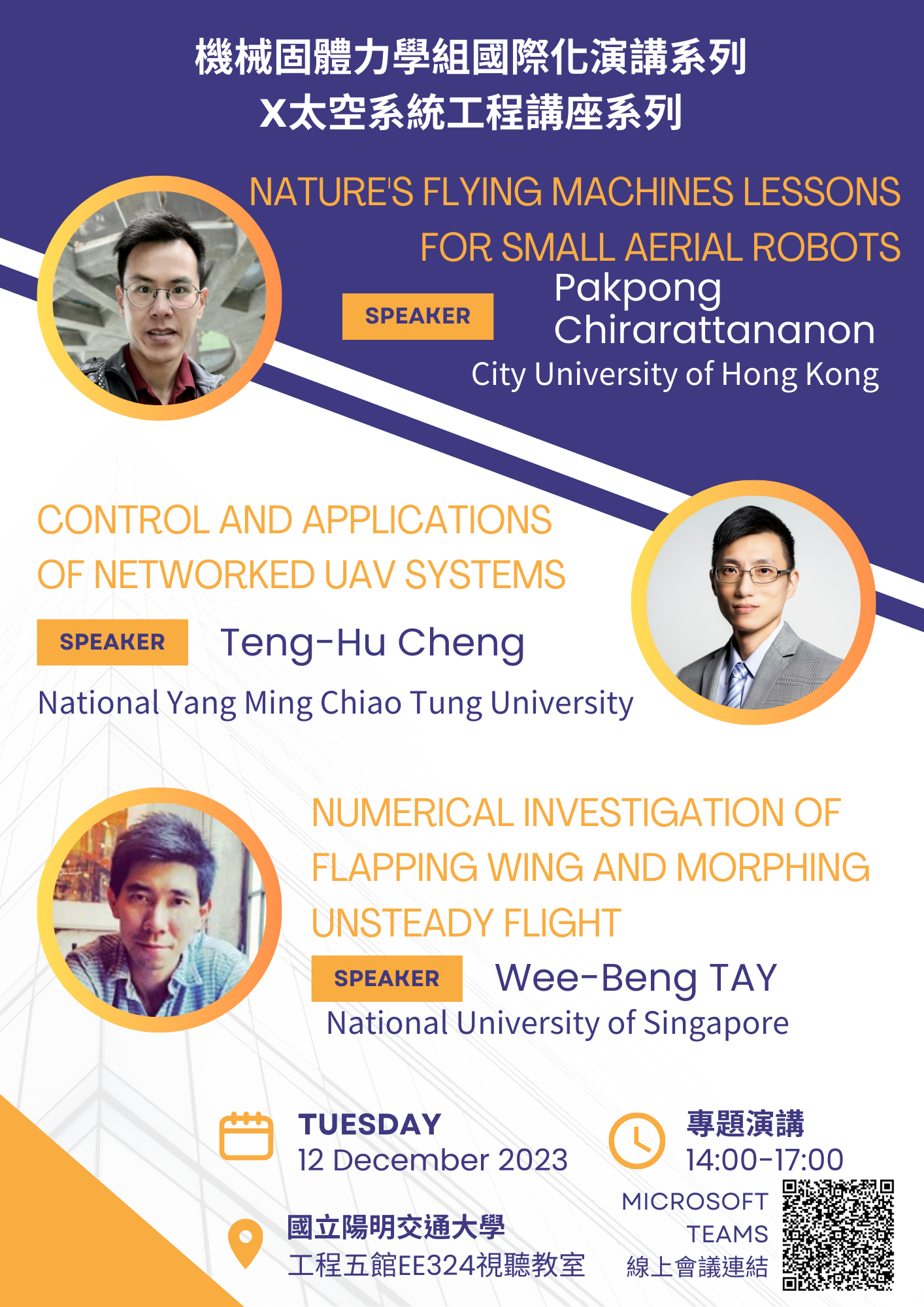 Registration form for online conference: https://forms.gle/hve4R72rpA4J1ssCA
Registration form for online conference: https://forms.gle/hve4R72rpA4J1ssCAOnline participation meeting link: https://reurl.cc/V4bddQ or scan the QR code on the right.

Nature's Flying Machines: Lessons for Small Aerial Robots
Speaker: Pakpong Chirarattananon, Departments of Biomedical Engineering and Mechanical Engineering at City University of Hong Kong
Date: 2023/12/12(Tue.)
Abstract
Recent years have seen rapid progress in the development of small flying robots, enabled by advances in materials, manufacturing, and control. However, flying at small scales poses fundamental challenges, including low Reynolds numbers that make flight inefficient and limited payload capacities that constrain battery size. These challenges have motivated roboticists to look to biology for inspiration, including insects with highly efficient flapping-wing flight. This talk will explore how bio-inspired design is enabling a new generation of small aerial robots that can achieve more with fewer components and less power. Examples will include flapping-wing robots that harness passive aerodynamic mechanisms, as well as revolving-wing drones and multimodal multirotors that leverage unsteady aerodynamics and versatile forms of locomotion. By drawing inspiration from biology, and focusing on minimalist design, these new robots are overcoming the power and weight constraints that have long limited small-scale flight.
BiographyPakpong Chirarattananon
Pakpong Chirarattananon is an Associate Professor in the Departments of Biomedical Engineering and Mechanical Engineering at City University of Hong Kong. He received his Ph.D. in Engineering Sciences from Harvard University in 2014 and his M.Phil. in Computational Biology and B.A. in Natural Sciences from the University of Cambridge. His research focuses on biologically-inspired robotic systems, micro aerial vehicles, and hybrid locomotion. Recently, he developed revolving-wing drones, flapping-wing robots, and multimodal multirotors, with related publications in Science, Nature, and Science Robotics. He uses intelligent mechanisms to solve dynamics and control problems, and enhances the performance of robotic devices through improved understanding of interactions between mechanical design, actuation, dynamics, control, and environmental factors. He has received several best paper awards, including the 2021 IEEE Transactions on Robotics King-Sun Fu Memorial Best Paper Award.
Control and Applications of Networked UAV systems
Speaker: Teng-Hu Cheng, Department of Mechanical Engineering, NYCU
Date: 2023/12/12(Tue.)
Abstract
Since UAVs are agile robots, they have been adopted to solve a diverse range of challenging problems. This talk will introduce the control and challenges of UAV systems such as distributed formation control, SLAM and motion planning for autonomous UAV, distributed cooperative control, tracking control of a moving target with unknown motion. The tracking control presents a method based on applying a DNN for detecting a moving target (e.g., car) undergoing unknown motion and collisions can be avoided using the control barrier functions (CBFs). The main challenges are to control both the relative positions and angles between the target and the UAVs to within desired values, and to guarantee that the generated control inputs to the UAVs are feasible (i.e., within their motion capabilities). Moreover, the UAVs are controlled to ensure that the target always remains within the fields of view of their onboard cameras. To the best of our knowledge, this is the first work to apply multiple UAVs to cooperatively track a dynamic target while ensuring that the UAVs remain connected and that both occlusion and collisions are avoided.
BiographyTeng-Hu Cheng
Teng-Hu Cheng received the Ph.D. degree from the Department of Mechanical Engineering, University of Florida, Gainesville, FL, USA, in 2015. In 2016, he joined the Department of Mechanical Engineering, National Yang Ming Chiao Tung University, Hsinchu, Taiwan. He received the O. Hugo Schuck Best Paper Award from the American Automatic Control Council in 2015. He also received and 3-year MOST grant for excellent young scholar in 2018, and AIslanders Show-excellent performance from MOST in 2018. He received Ta-You Wu Memorial Award from National Science Council in 2023. His research interests include robotics, autonomous systems, networked system control, switched control, event-driven control, and nonlinear control.
Numerical investigation of flapping wing and morphing unsteady flight
Speaker: Dr. Wee-Beng TAY, Department of Mechanical Engineering, National University of Singapore
Date: 2023/12/12(Tue.)
Abstract
Insects and birds have long been inspiring us to create flying vehicles which resemble them, due to their excellent maneuverability and speed. The popularity of flapping wing micro aerial vehicles (FMAVs) led to numerous studies, focusing on different areas. In this presentation, I am going to talk about my numerical work on flapping wing and unsteady morphing wing. Some of these areas include simulation of flapping wing MAV based on wing deformation capture analysis, effect of different types of wing-wing interactions in flapping MAVs and numerical Simulation of Flapping Wing MAVs in V-formation. Lastly, I will also discuss about the numerical simulation of the landing manoeuvre of a morphing unmanned aerial vehicle. Through these simulations, we have a better understanding of the underlying aerodynamics of flapping wing and unsteady morphing wing.
BiographyDr. Wee-Beng TAY
Dr. Wee-Beng TAY obtained his Bachelor of Engineering, Master of Engineering and PhD from the National University of Singapore in 2001, 2004 and 2009 respectively. Subsequently, he went to the Taiwan’s National Taiwan University and the Netherlands’s Delft University of Technology to do his postdoctorate. He joined Temasek Laboratories in November 2013. His research interest includes flapping wing aerodynamics, immersed boundary method, machine learning and unsteady micro aerial vehicles manoeuvres.
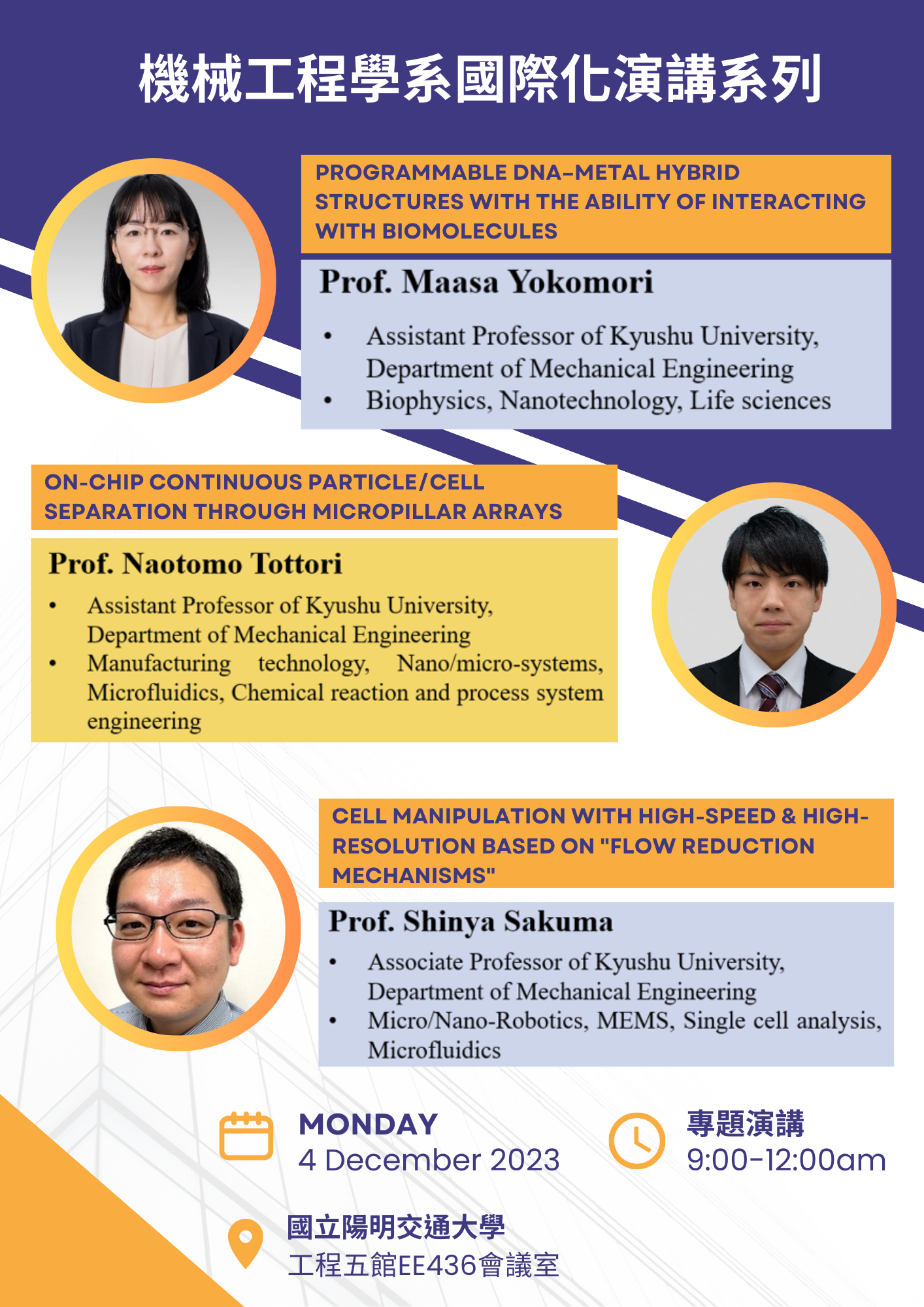 Title 1. Massive integrated on-chip gel actuator for single cell manipulations
Title 1. Massive integrated on-chip gel actuator for single cell manipulationsSpeaker: Prof. Takeshi Hayakawa, Faculty of Science and Engineering, Chuo University
Date: 2023/12/04(Mon.)
Abstract
Single cell manipulation is important technique to realize various single cell analyses. Especially, single cell manipulations on a microfluidic chip enables highthroughput, high-content and low cost single cell analyses. To realize various single cell manipulations on a microfluidic chip, on-chip actuators are essential components. We proposed light-driven on-chip hydrogel actuator made of themoresponsive hydrogels. The actuators are patterned with light absorber to control its temperature. By irradiating an actuator with light, we can increase temperature of the actuator and actuator it. Thus, the proposed actuator can be driven without any wiring. The proposed actuator can be fabricated with size of 10 um order by using photolithography. Thus, larger number of actuator can be integrated in a microfluidic chip and independently driven. The proposed actuator will contribute to high-throughput parallel processing of single cell analysis on a chip.
BiographyProf. Takeshi Hayakawa
Takeshi Hayakawa received the B.S. and M.S. degree from the the Department of Physics, Tokyo University of Science, Tokyo, Japan, in 2009 and the Ph.D. degree from Nagoya University, Nagoya, Japan, in 2015. He became an Associate Professor with Nagoya University in 2015. He became an Assistant Professor with the Department of Precision Mechanics of Chuo University, Japan in 2017 and promoted to Associate Professor. His research interests are micro/nanorotobics, microfluidics, and MicroTAS
Title 2. Nanoscopic design of molecular delivery using “nanoparticles based on lipids”
Speaker: Prof. Niko Kimura, Division of Advanced Mechanical Systems Engineering, Institute of Engineering, Tokyo University
Abstract
Recent years have witnessed dramatical progress in development of novel nanometer sized pharmaceuticals using nanoparticles based on lipids (LNPs). LNPs are biocompatible nanocarriers for delivering biomolecules and functional nanomaterials into live-cells. Up to the present time, we constructed microfluidic methods for LNP production having desired physical characteristics. In the microfluidic methods, we can obtain LNPs by just introducing two types of solutions: lipids dissolved ethanol solution and aqueous solution. In the micro-meter scaled channel, due to the low Reynolds number, a stable liquid–liquid interface between lipophilic phase and aqueous phase are formed and allows homogeneous self-assembling. Hence, we can obtain desired LNPs by controlled self-assembly. Use of designed LNPs helped to clarify the extent of the impact of the tunable physical characteristics that are inseparably related to each other, on transportation, and as a result provide a bidirectional guidepost for streamlined design and understanding of the biofunctions of LNPs. In addition, designed LNPs allowed to construct a novel concept of “Avatar cell” and visualize designed cell-cell communication and spatial controlled delivery.
BiographyProf. Niko Kimura
• Doctor of Philosophy in Engineering, (March 15, 2021) Graduate School of Chemical Sciences and Engineering, Hokkaido University, Japan
• Assistant Professor, (April 1, 2021–August 31, 2023) Department of Applied Chemistry, Faculty of Engineering, Kyushu University, Japan
• Senior Assistant Professor, (September 1, 2023–) Division of Advanced Mechanical Systems Engineering, Institute of Engineering, Tokyo University of Agriculture and Technology, Japan
Title 3. LCI-S and TDCSS, the pioneering tools to reveal cellular secretory responses
Speaker: Prof. Yoshitaka Shirasaki, Research Center for Advanced Science and Technology, The University of Tokyo
Abstract
Intercellular communication, which is essential for maintaining the complex harmony of living systems, is mediated by humoral factors. A crucial issue in this field concerns the diversity at the single-cell level in both the population and timing of humoral factor production. Conventional bulk assays have difficulty tackling this complex challenge, and advanced techniques with high spatiotemporal resolution are needed to characterize the secretion activity of individual cells. To address this challenge, we have developed Live Cell Imaging of Secretion Activity (LCI-S), which facilitates real-time visualization of dynamic cellular activity associated with the release of humoral factors by using a wash-free Fluorospot assay on a total reflection fluorescence microscope. LCI-S has been successfully demonstrated to visualize the production of IL-1 in regulated cell death processes such as pyroptosis and necroptosis. LCI-S also revealed how the secretion activity of group 2 innate lymphocytes (ILC2), which is critical for the initiation of type 2 immune responses, is initiated. Furthermore, combined with comprehensive gene expression analysis by time-dependent cell state selection (TDCSS), LCI-S revealed significant changes in gene expression patterns as ILC2 undergoes a transition to the active state.
 BiographyProf. Yoshitaka Shirasaki
BiographyProf. Yoshitaka ShirasakiEducation: Ph.D. degree in bioscience and biotechnology, graduate school of science and engineering, Waseda University, Japan.
Research Achievements: On-chip sorter of thermo-sensitive hydrogels by laser heating manipulation. Live cell imaging of secretory response and gene expression analysis, and its application research and commercialization.
Title 4. On-chip continuous particle/cell separation through micropillar arrays
Speaker: Prof. Naotomo Tottori, Department of Mechanical Engineering, Kyushu University
Abstract
Separation and purification of target particles from a heterogeneous population in a suspension is an essential step for the sample preparation for biological and chemical analysis. Presently, microfluidic techniques for particle separation have been attracting attention because of their advantages of minimizing the processed sample volume as well as ease of integration with other elements for comprehensive analysis. As one of the promising passive separation techniques, deterministic lateral displacement (DLD) has been extensively studied because of the advantage of continuous separation of various-sized particles (e.g. from nanometer to millimeter) based on their effective sizes at high resolution through the micropillar arrays. In this presentation, I introduce my recent research topics related to microfluidic devices for particle/cell separation through DLD micropillar arrays.
BiographyProf. Naotomo Tottori
Naotomo Tottori received Dr. Eng. in mechanical engineering from Tokyo Institute of Technology in 2018. Presently, he is an assistant professor working in Department of Mechanical Engineering, Faculty of Engineering, Kyushu University, Japan. His current research interest mainly includes microfluidic particle separation and droplet microfluidic systems.
Title 5. Programmable DNA–metal hybrid structures with the ability of interacting with biomolecules
Speaker: Prof. Maasa Yokomori, Department of Mechanical Engineering, Kyushu University
Abstract
Nucleic acids, which are essential biomolecules with genetic information, can also provide a powerful and flexible path towards self-assembly of nanomaterials with designed structure and functionalities. In particular, DNA-based structures that can encapsulate nanoscale molecules, such as proteins, have great potentials in various applications including drug carriers and reaction fields. However, DNA-based structures have problems with their rigidity and stability under dry conditions, which limits their applications. In this talk, I will present my recent work on developing a new type of DNA-metal hybrid structures for macromolecular encapsulation. DNAfunctionalization enables to fabricate porous colloidal crystals by controlling the distance between nanoparticles and their spatial arrangement in a precise manner. Proteins such as genome editing enzyme, CRISPR/Cas9 RNP, were successfully encapsulated into the gold colloidal crystals by harnessing the hollow spaces in the crystal lattices and their affinities for the target molecules. The potential use of DNAmetal hybrid crystals as the carriers for direct protein delivery into plant cells with hard cell walls via biolistic bombardment was also demonstrated. The affinity with biomolecules, rigidity, structural regularity, and optical properties of the crystals are expected to be utilized for carriers in drug delivery systems, biosensors, and the creation of new materials.
BiographyProf. Maasa Yokomor
Maasa Yokomori received her Ph.D. degree from the Graduate School of Arts and Sciences, the University of Tokyo in 2018. She joined Institute of Materials and Systems for Sustainability, Nagoya University in 2019 as postdoctoral research fellow. Since 2023, she is an assistant professor of Department of Mechanical Engineering, Kyushu University. Her research interests include DNA nanotechnology, selfassembled functional DNA materials, biohybrid nanoarchitectures and bioanalysis.
Title 6. Cell manipulation with high-speed & high-resolution based on "flow reduction mechanisms"
Speaker: Prof. Shinya Sakuma, Department of Mechanical Engineering, Kyushu University
Abstract
Among the considerable cell manipulation techniques, the manipulations based on fluid control have been widely used because of its compatibility with the microfluidic system. Since Reynolds number, which is the ratio of inertial force to viscous force, generally takes a small value in microchannels, we can utilize stable environment in on-chip cell manipulation/analysis. Up to the present time, we integrated microrobotics with microfluidics based on mirofabrication technologies for high-throuput cell manipulation/analysis, and achieved new functions and applications; high-resolution cell positioning; high-speed and high-resolution pipetting; high-speed on-chip cell sorting. In this presentation, I will introduce the cell manipulations with high-speed and high-resolution, which are revealed by the "flow reduction mechanism". The mechanism is based on the embedded elasticity of the microfluidic circuit, which works as a kind of the temporal buffer tank against to the input flow. I will show the examples of the on-chip cell positioning with sub-pixel resolution of a visual feedback control, and the picotiter pipetting with hundreds Hz actuation, which are achieved by the parallelly, and serially arranged flow reduction mechanism, respectively.
BiographyProf. Shinya Sakuma
Shinya Sakuma received the Ph.D. degree from Nagoya University in 2013. He became a postdoctoral fellow with the Department of Mechanical Engineering, Osaka University. He had been an Assistant Professor with the Department of MicroNano Systems Engineering, Nagoya University from 2013 to 2020. He has been an Associate Professor with the Department of Mechanical Engineering, Kyushu University form 2020.
Smart Materials, Adaptive Structures and Intelligen
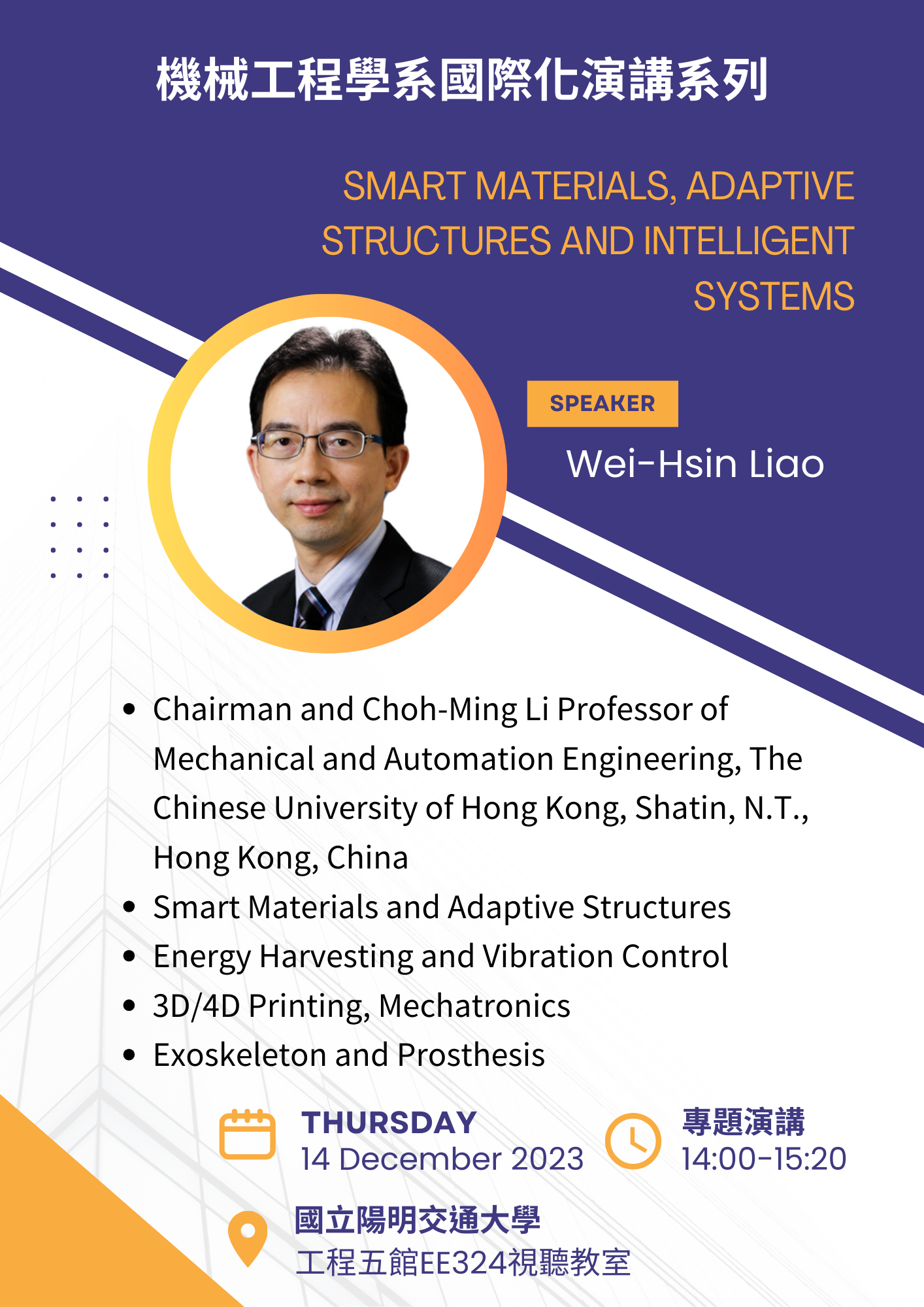 t Systems
t SystemsSpeaker: Prof. Wei-Hsin Liao, Chairman and Choh-Ming Li Professor of Mechanical and Automation Engineering
The Chinese University of Hong Kong , Shatin, N.T., Hong Kong, China
Date: 2023/12/14(Thu.)
Abstract
Smart materials are those that alter their shape, stiffness or other properties when they are subjected to changes in temperature, electrical or magnetic field. By utilizing these adaptive features, smart materials can be built as sensors and actuators. Integrating with controllers, such systems perform work like nerves, muscles, and brains in our human bodies. Piezoelectric material and magneto-rheological (MR) fluid have been used for controlling vibration. They have been applied to hard disk drives and vehicle suspension. Energy can also be harvested from vibration and human motion. Piezoelectric and electromagnetic power generators were used to transform the mechanical energy from vibration and human motion into electrical energy. The self-powered systems will be more environmentally friendly since they are using otherwise wasted mechanical energy from the vibration and human motion. On the other hand, exoskeletons that can assist people with impaired mobility have been developed. With the developed device, paralyzed individual can regain the ability to stand up and walk. Smart ankle-foot prosthesis with compact cam-spring mechanism have also been implemented to help amputees walk with less effort while having more symmetrical gait. Utilizing additive manufacturing into smart materials has led to 4D printing technology for creating devices that can change their shape and/or function on-demand and over time. Adaptive structures capable of self-expanding and self-shrinking were created by 4D printing. Actuator units were designed and fabricated directly by printing fibers of shape memory polymers in flexible beams with different arrangements. They can serve as tubular stents and grippers for biomedical or piping applications. In this talk, related research projects and key results will be presented.
Prof. Wei-Hsin LiaoBiography
Wei-Hsin Liao received his Ph.D. in Mechanical Engineering from The Pennsylvania State University, University Park, USA. Since August 1997, Dr. Liao has been with The Chinese University of Hong Kong, where he is currently Department Chairman and Choh-Ming Li Professor of Mechanical and Automation Engineering. His research has led to publications of over 380 papers in international journals and conference proceedings, and 27 granted patents. He was the Conference Chair for the 20th International Conference on Adaptive Structures and Technologies in 2009; the Active and Passive Smart Structures and Integrated Systems, SPIE Smart Structures/NDE in 2014 and 2015. He received the T A Stewart-Dyer/F H Trevithick Prize in 2005 awarded by the Institution of Mechanical Engineers; the Best Paper Award in Structures in 2008, the Best Paper Award in Mechanics and Material Systems in 2017, the Energy Harvesting Best Paper Award in 2021, the Best Paper Award in Structural Dynamics and Control as well as Leonardo Da Vinci Award in 2023 from the ASME. He is the recipient of the 2020 ASME Adaptive Structures and Material Systems Award and the 2018 SPIE SSM Lifetime Achievement Award, to recognize his outstanding contributions to the advancement of smart structures and materials. Dr. Liao currently serves as an Associate Editor for Journal of Intelligent Material Systems and Structures, and on the Executive Editorial Board of Smart Materials and Structures. Dr. Liao is a Fellow of ASME, HKIE, and IOP.
 Theory, Numerical Analysis and Experiments of Acoustic and Seismic Metamaterials and Metastructures
Theory, Numerical Analysis and Experiments of Acoustic and Seismic Metamaterials and MetastructuresSpeaker: Prof. C W LIM (林志華), Department of Architecture and Civil Engineering, City University of Hong Kong
Date:2023/12/28(Thu.)
Abstract
The recent surge in the number of studies on seismic metamaterials is testimony to the fact that the concept of photonic crystals, phononic crystals and acoustic metamaterials [1-3] is no longer limited to basic theories and dynamic characteristics. Apart from the peculiar observation including negative stiffness, negative mass density negative refraction properties, etc., auxetic metamaterials that govern negative Poisson’s ratio, nonreciprocal wave phenomena, origami/kirigami effects also find potential applications in geophysics and earthquake engineering [4-5]. Except man-made synthetic resonators/metastructures, recently forest trees at geophysical scale are reported as naturally available seismic metamaterials with capability to mitigate ground born ambient vibrations and incoming seismic waves at subwavelength frequency region. The work to be presented here elaborates a class of materials and structures ranging from engineered phononic crystals and acoustic metamaterials in Fig (a,b) to natural seismic metamaterials in Fig. (c,d) that show exotic yet with outstanding application potentials. Besides discussing the peculiar yet wonderful wave propagation characteristics of periodic structures for wave active control, topological protected interface modes, etc., the exciting wave dispersion response that found applications for manipulation Rayleigh wave and possible forestation as a means for geographical regional isolation against ground surface wave motion will also be presented.
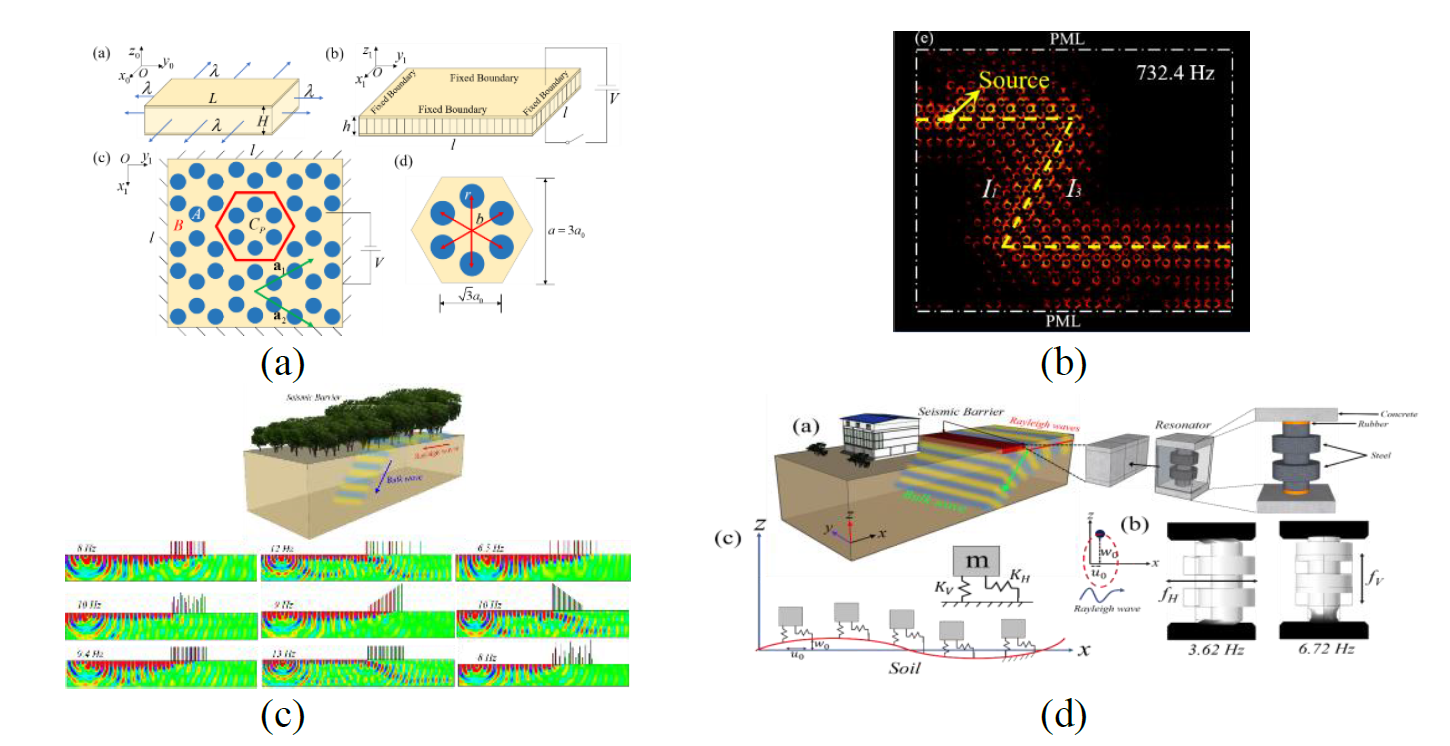
REFERENCES
- M. I. Hussein, M. J. Leamy, and M. Ruzzene, Applied Mech. Reviews, 66 (4), 040802, 2014.
- Muhammad and C.W. Lim, Ultrawide bandgap by 3D monolithic mechanical metastructure for vibration and noise control, Archives of Civil and Mechanical Eng., 21(2), Article: 52, 2021.
- Zhenyu Chen, Muhammad, Xiangyu Wang and C.W. Lim, Sinusoidal lightweight phononic crystal lattice for broadband and low frequency topologically protected elastic wave transportation, J. Appl. Physics, 130(4), Article 045108, 2021.
- Muhammad, C.W. Lim and J.N. Reddy, Built-up structural steel sections as seismic metamaterial for surface wave attenuation with low frequency wide bandgap in layered soil medium, Engineering Structures, 188, 440-451, 2019.
- Muhammad and C.W. Lim, Natural seismic metamaterials: The role of tree branches in the birth of Rayleigh wave bandgap for ground born vibration attenuation, Trees - Structure and Function, 35(4), 1299-1315, 2021.
BiographyProf. C W LIM (林志華)
Ir Professor Lim received a BEng from University of Technology of Malaysia, MEng and PhD from National University of Singapore and Nanyang Technological University, respectively. Prior to joining City University of Hong Kong (CityU), he was a post-doctoral research fellow at The University of Queensland and The University of Hong Kong. Professor Lim is also a visiting professor at various universities including the University of Western Sydney, Dalian University of Technology, Huazhong University of Science and Technology, etc.
Professor Lim receives global recognition for original research in applied and computational mechanics. He was awarded the J.N. Reddy Medal 2020 for “significant and original contributions to vibration of plates and shells, smart piezoelectric structures, nanomechanics, and symplectic elasticity.” He published over 380 articles, H-index 64, over 15,200 citations. He has co-authored one very well-selling title in Engineering Mechanics titled “Symplectic Elasticity”, as recorded in April 2010 by the publisher, World Scientific. As the first and corresponding author in another work, he established one ground-breaking theory and the paper has accumulated over 1,220 citations since first published in 2015. It is also a highly cited paper in JMPS as well as the most cited paper since 2004 in the journal. His other work was granted the IJSS 2004-2008 most cited article award. He also published a research paper in Nature Communications. He was awarded Top Referees in 2009, Proc. A, The Royal Society.
Professor Lim holds fellowships of ASME, ASCE, EMI, and HKIE. He was awarded the Tan Chin Tuan Exchange Fellowship by Nanyang Technological University in 2016. Recently he was elected by secret votes to deliver a Plenary Lecture at World Congress on Computational Mechanics 2022[1], the largest biennial meet for computational scientists. WCCM 2020 recorded over 400 mini-symposia and over 5,000 papers accepted[2]. He has delivered over 60 plenary/keynote speeches worldwide. In addition, he also presented a keynote speech at PHM-2021 which is a reputable IEEE international conference. In another scientific occasion, Professor Lim was one of the distinguished speakers at a forum on 28 May 2022 organized by Chinese Science Bulletin that were broadcasted online on five different virtual platforms. He was the opening speaker and it was marvelous to note that the scientific forum accumulatively attracted a remarkable over 30,000 strong audience online.
He holds the Chair of Selection Committee (2017-present) for J.S. Rao Medal in Vibration Engineering, GC member of IACM and APACM since 2019, Selection Committee Member of APACM awards, Vice Chair/Chair (2018-2022) for ASCE/EMI Stability Committee, Vice Chair (2021-2023) and Chair (2023-Present) for ASME Int. HK Section, and Technical Committee Member for IFToMM since 2011.
He received multiple research grants totaling millions of dollars, one FE software and four patents. He serves on over 20 journal editorial boards, notably JoMMS (co-Editor-in-Chief), JVET (Managing Editor), AMM (International Subject Editor), JSV (Subject Editor), RSOS (Engineering Subject Editor), etc.

 NYCU ME
NYCU ME